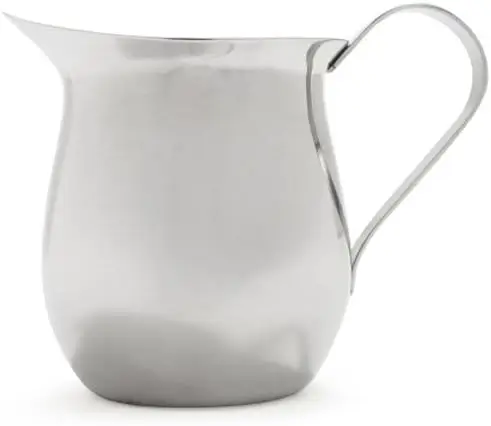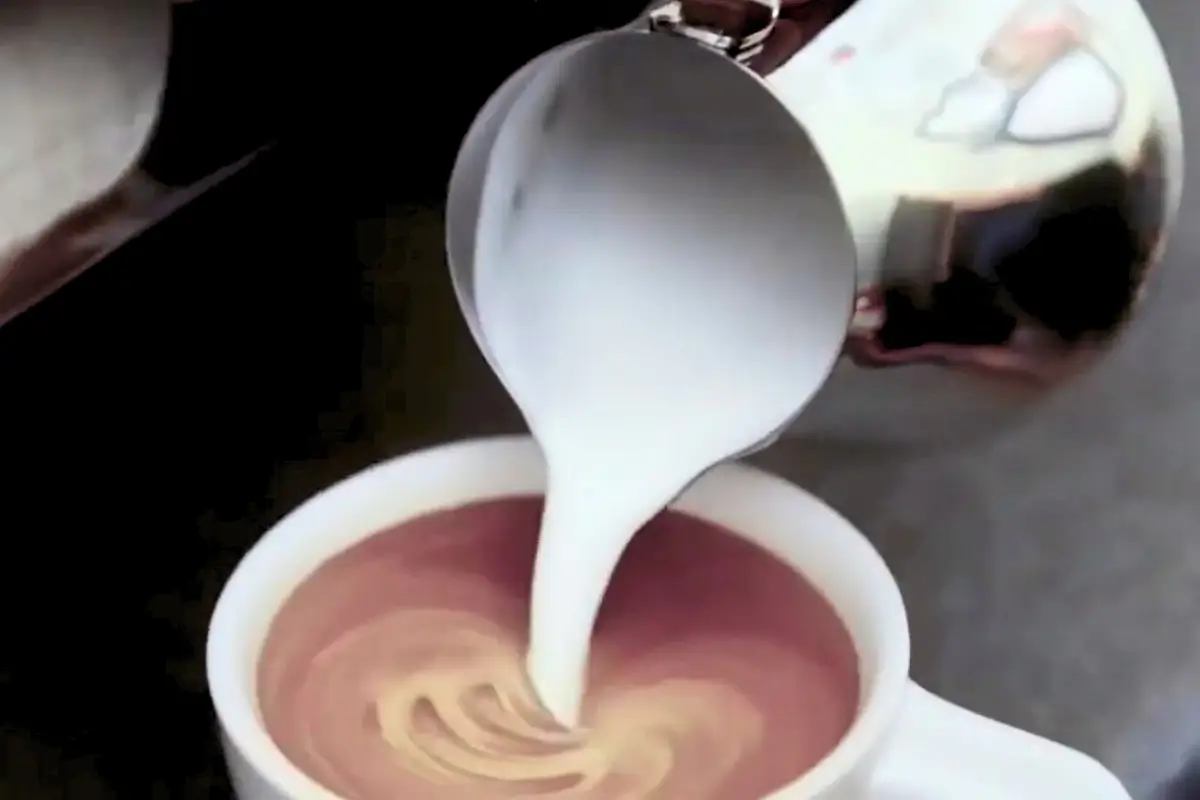An espresso brew pitcher, often called a milk frothing pitcher, is essential for making creamy, well-textured milk for espresso drinks. It allows precise control while steaming and pouring milk.
Espresso brew pitchers are vital for baristas and coffee enthusiasts aiming to craft perfect lattes and cappuccinos. These pitchers come in various sizes and materials, ensuring versatile options for different preferences and needs. Stainless steel pitchers are the most popular due to their durability and heat retention properties.
The spout design is crucial for creating latte art, allowing precise control over the milk flow. Investing in a high-quality espresso brew pitcher can significantly enhance your coffee-making experience, leading to consistently delicious results and beautifully crafted beverages.
The Art Of Espresso Making
Espresso making is a blend of science and art. Each cup carries the essence of perfect brewing. The right tools can improve your espresso experience. The Espresso Brew Pitcher is one such tool. It ensures precision and consistency.
Crafting The Perfect Shot
Creating the perfect espresso shot requires skill and patience. First, use freshly ground coffee beans. Ensure they are finely ground. The grind size impacts the flavor. Next, measure the coffee accurately. Use 18-20 grams for a single shot. Tamp the coffee evenly with firm pressure.
Set your machine to 9 bars of pressure. Brew for 25-30 seconds. The shot should have a rich, golden crema. This indicates a well-crafted espresso shot.
The Role Of Precision In Espresso
Precision is crucial in espresso making. Small deviations can alter the taste. Use a digital scale to measure coffee and water. Keep the temperature between 195-205°F. This range extracts the best flavors.
The Espresso Brew Pitcher ensures you pour accurately. It also helps control the milk frothing process. Consistent milk texture enhances the espresso experience. Precision in every step guarantees a perfect cup.
| Step | Action |
|---|---|
| 1 | Grind coffee beans finely |
| 2 | Measure 18-20 grams of coffee |
| 3 | Tamp coffee evenly |
| 4 | Set machine to 9 bars |
| 5 | Brew for 25-30 seconds |
Choosing The Right Espresso Pitcher
Selecting the perfect espresso pitcher is crucial for a great coffee experience. The right pitcher impacts both the taste and presentation of your espresso. This guide will help you make an informed choice.
Materials Matter: Glass Vs. Stainless Steel
Glass pitchers offer a clear view of the espresso. You can see the brewing process, which can be visually satisfying. They are also easy to clean and do not retain odors. But, they are fragile and can break easily.
Stainless steel pitchers are durable and long-lasting. They maintain temperature better than glass. They are also resistant to rust and are lightweight. However, they can be harder to clean and may retain some odors.
| Material | Pros | Cons |
|---|---|---|
| Glass | Clear view, Easy to clean | Fragile, Can break easily |
| Stainless Steel | Durable, Maintains temperature | Harder to clean, May retain odors |
Size And Shape Considerations
The size of the pitcher affects how much espresso you can brew. Choose a size that fits your needs. For single servings, a smaller pitcher works well. For multiple servings, opt for a larger one.
The shape of the pitcher influences the pouring precision. A tapered spout offers better control. This is important for latte art and avoiding spills. A wider base provides stability during brewing.
- Smaller pitchers: Ideal for single servings.
- Larger pitchers: Better for multiple servings.
- Tapered spout: Provides precise pouring.
- Wider base: Ensures stability.
Features Of Top-quality Pitchers
Understanding the features of top-quality pitchers can enhance your espresso brewing experience. These features ensure precision, control, and consistency. Let’s delve into what makes a pitcher stand out.
Spout Design For Accurate Pouring
The spout design is crucial for accurate pouring. A well-designed spout allows you to pour the milk smoothly. This is essential for creating latte art. A narrow spout offers better control. It helps in making intricate designs.
A pitcher with a wide spout is ideal for beginners. It makes it easier to pour without spills. The shape of the spout also affects the flow rate. A good spout ensures a steady stream of milk. This helps in achieving the desired texture.
Insulation For Temperature Control
Insulation is key for maintaining milk temperature. A double-walled pitcher keeps the milk at the right temperature. This is vital for frothing and steaming. It ensures that the milk does not cool down too fast.
Insulated pitchers are also safer to handle. The outer wall stays cool to the touch. This reduces the risk of burns. High-quality insulation also improves energy efficiency. It keeps the milk warm for longer periods.
| Feature | Benefit |
|---|---|
| Spout Design | Accurate Pouring |
| Insulation | Temperature Control |
Top-quality pitchers combine these features. This ensures a perfect cup every time. Choose a pitcher that suits your needs. Enjoy making your espresso with precision and ease.
The Importance Of A Good Handle
A great espresso brew pitcher should have a well-designed handle. The handle impacts the user’s comfort and stability. A poor handle can make pouring difficult and messy. This section highlights why a good handle is essential.
Ergonomics And Comfort
An ergonomic handle fits naturally in your hand. This design reduces strain on your wrist. You can pour with ease and precision. The handle should be smooth and rounded.
- Comfortable grip
- Reduces wrist strain
- Easy to hold for long periods
Some handles have rubber or silicone coverings. These materials add extra comfort. They also provide a non-slip grip. This is especially useful when your hands are wet.
Stability During Pouring
Stability is crucial when pouring espresso. A solid handle helps maintain control. This is important for creating latte art. A good handle prevents accidental spills.
| Feature | Benefit |
|---|---|
| Non-slip grip | Prevents spills |
| Balanced design | Ensures steady pouring |
| Heat resistance | Protects your hand |
A good handle also keeps the pitcher balanced. This balance is essential for precise pouring. Without it, your espresso might spill or splash. Choose a pitcher with a sturdy, well-balanced handle.
Measuring And Dosing With Precision
Precision is key in brewing the perfect espresso. The espresso brew pitcher ensures each step is accurate. From measuring water to dosing coffee, every gram matters.
Built-in Measurements: A Barista’s Ally
The espresso brew pitcher features built-in measurements. These markings help baristas measure water accurately. No need for extra tools. Just use the pitcher and save time.
Clear, easy-to-read markings make the process straightforward. These markings ensure every brew is consistent. Whether you’re at home or in a café, precision is guaranteed.
| Feature | Benefit |
|---|---|
| Built-in measurements | Ensures accurate water measurement |
| Clear markings | Makes reading easy and quick |
| Time-saving | No need for extra tools |
The Balance Between Dose And Yield
Finding the right balance between dose and yield is crucial. The espresso brew pitcher helps achieve this balance. Use it to measure coffee grounds and water precisely.
Here’s a simple guide:
- Use the pitcher to measure your coffee grounds.
- Adjust the dose based on the desired strength.
- Measure the water using the built-in markings.
- Maintain consistency for every brew.
This method ensures a perfect espresso every time. Consistency is key in professional coffee making. The pitcher helps maintain this consistency effortlessly.
Precision in measuring and dosing creates a balanced espresso. A balanced espresso has rich flavors and a smooth finish. The espresso brew pitcher is essential for achieving this balance.
Credit: www.amazon.com
Maintenance And Care Tips
Proper maintenance and care of your Espresso Brew Pitcher ensure its longevity. Follow these tips to keep your pitcher in top condition. Clean it regularly and handle it with care. Read on for detailed advice.
Cleaning Best Practices
Regular cleaning of your Espresso Brew Pitcher is crucial. Here are some best practices:
- Rinse the pitcher immediately after each use.
- Use warm water and a mild detergent.
- Avoid abrasive sponges; use a soft cloth instead.
- Ensure all detergent residue is thoroughly rinsed.
For a deeper clean:
- Fill the pitcher with hot water and a bit of vinegar.
- Let it sit for 15 minutes.
- Rinse thoroughly with warm water.
Tip: Clean the spout and handle carefully.
Longevity Of Your Espresso Pitcher
Maintaining your Espresso Brew Pitcher can extend its life. Here are some tips:
| Action | Frequency |
|---|---|
| Immediate Rinse | After Each Use |
| Deep Clean | Weekly |
| Inspect for Damage | Monthly |
Avoid exposing your pitcher to extreme temperatures. Store it in a dry place. Handle with care to prevent dents and scratches.
Regular maintenance ensures your Espresso Brew Pitcher performs well. Follow these tips for the best results.
Advanced Techniques For Espresso Enthusiasts
For espresso lovers seeking to elevate their brewing skills, mastering advanced techniques is crucial. This guide covers Latte Art Basics and Mastering Microfoam with a Pitcher. These skills enhance your espresso experience and impress your guests.
Latte Art Basics
Creating beautiful latte art requires practice and precision. Start with fresh milk and an espresso brew pitcher. The pitcher helps control the pour. Follow these steps:
- Steam the milk to 150°F (65°C).
- Swirl the milk to remove large bubbles.
- Hold the pitcher high above the cup.
- Pour over the espresso shot in a slow, steady stream.
- Lower the pitcher as the cup fills.
- Create patterns like hearts, rosettas, or tulips.
Mastering Microfoam With A Pitcher
Microfoam is key for a smooth texture. Use an espresso brew pitcher for best results. Follow these tips:
- Start with cold milk.
- Submerge the steam wand just below the surface.
- Turn on the steam and keep the wand steady.
- Let the milk swirl to create tiny bubbles.
- Heat to 150°F (65°C) for perfect microfoam.
| Step | Action |
|---|---|
| 1 | Use cold milk. |
| 2 | Submerge steam wand. |
| 3 | Turn on steam. |
| 4 | Swirl milk. |
| 5 | Heat to 150°F. |
These techniques transform your coffee routine. Practice regularly for consistent results.
Accessories To Complement Your Pitcher
Owning an espresso brew pitcher is just the beginning of your coffee journey. To enhance your brewing experience, several accessories can help. These tools ensure you get the best espresso shots every time.
Tamper Selection For Consistent Shots
A good tamper is crucial for achieving consistent espresso shots. Tampers come in different sizes and materials. Choose a tamper that fits your portafilter perfectly.
- Flat Base Tamper: Ensures even pressure across the coffee puck.
- Convex Base Tamper: Helps in reducing channeling during extraction.
- Material: Stainless steel tampers offer durability and weight.
Thermometers And Scales For Accuracy
Precision is key in espresso brewing. Thermometers and scales help you achieve that precision.
| Accessory | Function |
|---|---|
| Thermometer | Measures the temperature of milk and water. |
| Scale | Weighs coffee grounds and water for exact measurements. |
Using a thermometer ensures your milk is steamed to the perfect temperature. A scale helps in maintaining the right coffee-to-water ratio. Both tools are essential for a balanced cup of espresso.
Choosing The Right Espresso Machine
Choosing the right espresso machine is crucial for a perfect brew. Your Espresso Brew Pitcher deserves a machine that complements its functionality. Let’s explore how to make the best choice.
Compatibility With Your Pitcher
Ensure the espresso machine is compatible with your pitcher. The size of the portafilter matters. A standard pitcher fits with most machines. But check measurements to avoid mishaps.
Look for machines with adjustable spouts. This feature helps in fitting different pitcher sizes. Also, make sure the machine’s steam wand reaches your pitcher’s bottom. This ensures proper milk frothing.
Features For The Home Barista
Modern espresso machines come with exciting features. Programmable settings allow you to customize your brew. Some machines offer pre-infusion options. This enhances the flavor extraction process.
Built-in grinders are a great addition. Freshly ground beans make a huge difference. Look for machines with an auto-cleaning feature. This saves time and ensures hygiene.
Consider machines with a pressure gauge. This helps monitor the brewing pressure. Consistent pressure results in a perfect espresso shot.
| Feature | Benefit |
|---|---|
| Programmable Settings | Customizable brew |
| Built-in Grinder | Freshly ground beans |
| Auto-Cleaning | Time-saving and hygienic |
| Pressure Gauge | Consistent brewing |
Choose a machine that suits your needs and preferences. Your Espresso Brew Pitcher will thank you.
Frequently Asked Questions
What Is The Ratio Of Coffee Beans To Water For Espresso?
The ideal ratio for espresso is 1:2. Use 18 grams of coffee beans for 36 grams of water.
What Are The Brewing Ratios For Espresso Beverages?
Espresso brewing ratios vary. A standard espresso uses 1:2 (coffee to water). Ristretto is 1:1, and lungo is 1:3.
How Long Should A Single Shot Of Espresso Take?
A single shot of espresso should take 25 to 30 seconds to brew. This ensures optimal flavor and extraction.
How Much Espresso For A Double Shot?
Use 18-20 grams of coffee for a double shot of espresso. This ensures rich flavor and proper extraction.
Conclusion
Choosing an espresso brew pitcher can elevate your coffee experience. It ensures precision and enhances flavor. Invest in quality, and enjoy better brews daily. A perfect pitcher complements your brewing skills and equipment. Improve your coffee game with the right tools.
Enjoy the perfect espresso every time.



